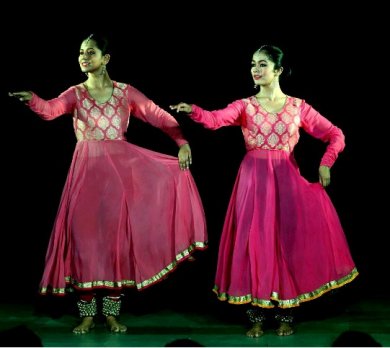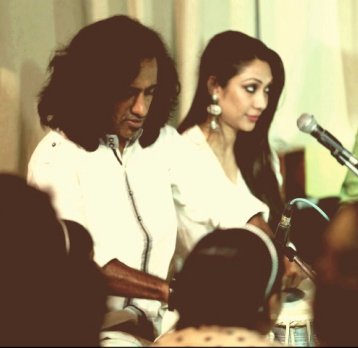
|   |

|   |
The process of empowerment - S D Desai e-mail: sureshmrudula@gmail.com March 13, 2016 A modest event significant in import prompts me to bring it to wider notice.  Krutika and Mihika Judging by the quality of performance, it was difficult to believe the two Kadamb dancers Krutika and Mihika were 15 years of age! On a significant March 8, they gave a feel of the process of getting empowered. One essayed the softer aspect of a woman in shringar. The other the latent raudra a modern woman is capable of, if need be, through Lord Shiva’s energy - the process of sloughing off the inhibited teenage feminine form and taking on one which gives them space, the freedom to be what they would like to be through an art pursuit of their choice.  Joby Joy and Sanjukta Sinha The emerging young dancers partook of – particularly in the elegant accuracy of their movement and delicately connotative mudras – something of their choreographer Sanjukta Sinha’s expressive skills through the body and its energy. It is no surprise at their age that their face and eyes are yet to emotionally mature and attain expressive richness. The competently engaging music (tabla - Joby Joy, sarangi - Vanraj Shashtri, vocal - Balraj Shashtri) took the presentation to a relatively high level and the dancers, occasional hiccups apart, rose up to it – both in the solos focusing on the two opposite rasas and the duet projecting a complementary combination of the two. Incidentally, what a welcome change in the Guru-Shishya relationship! To the octogenarian Kumiben taking her first steps in Kathak decades ago, the guru was a figure to be looked up to with awe and respect from a distance. Today, the young teacher hugs and holds her disciple tight by the shoulder. The traditional respect for the guru however remains intact. The disciple touches the guru’s feet a myriad times, demonstrating her utmost modesty. The seeker of Truth, Gandhiji said, needs to be humbler than a particle of dust. So does a seeker of Beauty, every dance learner knows. Kumiben is at times capable of showing spontaneous modern gestures. From the audience, she punctuated each performance with a thumbs-up for the dancer. Both the young dancers would cherish the response! 
A page from Charan Kanya
Another modest event highlighting the process of empowerment in an unconventional way took place on March 8. Young sisters Kanan and Keli Dhru, having had their postgraduate qualifications from Cambridge, one of them enjoying international recognition for her intellectual pursuits now, put their knowledge to social good particularly through their organization (Research Foundation for Governance in India). They published last year their innovative work Lawtoons that makes jargon-ridden laws easy to understand for the common man through cartoons. As part of this innovative project, in collaboration with the Canadian Consulate they sought to retell in English, with Ranjitha’s graphics, a folktale of a fearless fourteen-year old uneducated girl immortalized by a celebrated Gujarati poet and novelist Zaverchand Meghani in his spirited narrative poem Charan Kanya in Gujarati. Mahatma Gandhi hailed Meghani (1896-1947), who wrote the poem rakta tapakati so so jodi samaraangan-thi aave... (‘Batches of soldiers in their hundreds dripping blood, look, come from the battlefield...’), as Rashtriy Shayar and his birth anniversary was on March 9. Having guts, moral and physical, is an inborn trait of the Charan Kanya who has grown up in a natural environment, unspoiled by formal education. Singlehanded, in wilderness she dares and shoos a lion away. The Canadian Consulate printed the booklet Charan Kanya in English and distributed it at the prestigious Kalaghoda Arts Festival earlier during the month as a gesture of empowering girls. Dr. S.D. Desai, a professor of English, has been a Performing Arts Critic for many years. Among the dance journals he has contributed to are Narthaki, Sruti, Nartanam and Attendance. He guest-edited Attendance 2013 Special Issue. His books have been published by Gujarat Sahitya Academy, Oxford University Press and Rupa. After 30 years with a national English daily, he is now a freelance art writer. |